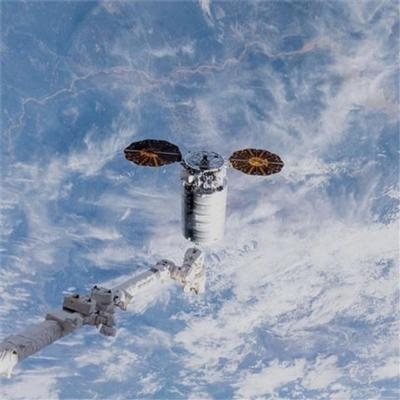"S.S. Rick Husband" Provided Record Shipment of Vital Cargo To ISS, Then Used As Technology Platform For In-Space Experiments
The second ISS resupply mission undertaken by Orbital ATK this year has come to a successful conclusion. The mission, known as OA-6, marked the company’s fifth CRS-1 mission and the first time its Cygnus has been used as an in-orbit research platform.

Orbital ATK, which named the Cygnus spacecraft the “S.S. Rick Husband” in honor of the late NASA astronaut, carried approximately 7,900 pounds of science experiments and cargo to the space station. The spacecraft also executed on three post-departure mission objectives, including the Spacecraft Fire Experiment-I (Saffire-I), the deployment of CubeSat satellites from the NanoRacks CubeSat Deployer and the Reentry Breakup Recorder with Wireless Sensors (REBR-W) test.
The Cygnus spacecraft that carried out the OA-6 mission departed the International Space Station on June 14, completing an 81-day stay. Prior to its departure, the astronauts loaded the cargo module with approximately 4,087 pounds of items for disposal. Earlier today, at approximately 9:29 a.m. EDT, Cygnus performed a safe, destructive reentry into Earth’s atmosphere over the Pacific Ocean east of New Zealand, marking the successful conclusion of the mission.
“Throughout the OA-6 mission, we were able to demonstrate the versatility and value of our Cygnus spacecraft, from its launch on an Atlas rocket, to the flawless delivery of the largest load of pressurized cargo in the CRS program’s history, to its ability to serve as a platform for in-space research,” said Frank Culbertson, President of Orbital ATK’s Space Systems Group.
On March 22, Cygnus demonstrated its compatibility with multiple launch vehicles for the second time as it lifted off from Cape Canaveral Air Force Station, Florida aboard a United Launch Alliance Atlas V rocket. Four days later, Cygnus docked with the International Space Station, delivering vital supplies and science experiments to the astronauts on board. As it departed the space station, Cygnus then served as an in-orbit research platform, further displaying its robust capabilities.
The first experiment to take place onboard Cygnus was Saffire-I, a technology demonstration designed by NASA’s Glenn Research Center. Saffire-I begins a series of tests to study the behavior of large scale fires in microgravity. Orbital ATK successfully sent the command to initiate the experiment, which intentionally lit a fire that occurred in the Cygnus pressurized cargo module. The experiment executed as intended and NASA’s Glenn Research Center is currently evaluating all data and imagery gathered from the test. Saffire-I and future Saffire experiments directly support the development of technologies and materials that will make deep space exploration spacecraft safer for astronauts who live and work in space and as NASA prepares for long duration missions on the journey to Mars.
Following the Saffire-I experiment, Cygnus then successfully deployed four of five CubeSats via a NanoRacks CubeSat Deployer. The satellites are now in orbit conducting their individual missions.
The final experiment of the OA-6 mission took place during Cygnus’ reentry into Earth’s atmosphere. Astronauts installed the Reentry Breakup Recorder with Wireless Sensors (REBR-W) on Cygnus prior to its departure from the station. REBR-W, developed by The Aerospace Corporation, will allow for better understanding of spacecraft behavior during atmospheric reentry and breakup, leading to improved vehicle safety and design in the future. REBR-W recorded and transmitted Cygnus’ safe, destructive reentry into Earth’s atmosphere that marked the successful conclusion of the OA-6 mission.
Preparations are underway for the company’s next CRS-1 mission, OA-5, which is targeted to launch later this summer from the Mid-Atlantic Regional Spaceport at NASA’s Wallops Flight Facility in Virginia. Orbital ATK is scheduled to complete 10 CRS-1 missions to the International Space Station before transitioning to launch cargo logistics missions under the CRS-2 contract in 2019.
(Image provided with Orbital ATK news release)
 ANN's Daily Aero-Term (05.01.24): Say Altitude
ANN's Daily Aero-Term (05.01.24): Say Altitude ANN's Daily Aero-Linx (05.01.24)
ANN's Daily Aero-Linx (05.01.24) Classic Aero-TV: Korean War Hero Twice Reborn
Classic Aero-TV: Korean War Hero Twice Reborn Airborne 04.29.24: EAA B-25 Rides, Textron 2024, G700 Deliveries
Airborne 04.29.24: EAA B-25 Rides, Textron 2024, G700 Deliveries Airborne Affordable Flyers 05.02.24: Bobby Bailey, SPRG Report Cards, Skydive!
Airborne Affordable Flyers 05.02.24: Bobby Bailey, SPRG Report Cards, Skydive!



